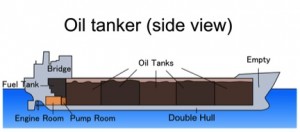
Lake Superior from Gros Cap Bluffs, Prince Township, Ontario. Photo: Fungus Guy.
Calumet Specialty Products refinery in Superior Wis. wants to ship oil across Lake Superior by 2015 if it can find a customer, said Dave Podratz plant manager.
Some people are concerned with shipping oil across the Great Lakes because of the pollution risk from oil spills, said Josh Mogerman, spokesmen for the Natural Resources Defense Council in Chicago. “This is a risk we need to look at very closely before we risk the water quality in the Great Lakes.”
The Calumet refinery is one of the only fueling stations on Lake Superior and that has been in operation since the late 90s, Podratz said. “We fuel all the boats in this part of the Great Lakes. The ones that are hauling limestone, iron ore and coal. They come into our fuel docks, and we fuel them with fuel oil.”
North Dakota and Canada have an oil boom going on right now, and they are shipping hundreds of thousands of barrels a day of crude oil out of North Dakota by rail, he said.
There just aren’t enough pipelines to get it to all the refineries, so Calumet is going to ship oil by tankers, Podratz said. “We are fortunate based on our location to the Enbridge pipeline that we could get that crude oil by pipeline which is the most efficient way to transfer oil.”
The Enbridge liquid pipeline called the Lakehead System transfers 43 different crude oil commodities from North Dakota to Chicago with an extension to Buffalo, according to the company website.
Oil is loaded on tankers and transported to refineries throughout the Great Lakes that are equipped to receive oil by ship, Podratz said. “It essentially is a cheaper way to get it to market than by rail.”
Right now Calumet Specialty Products is researching potential customers within the Great Lakes system. Calumet is also trying to find a company that would transfer the oil for them, said Adele Yorde, public relations manager for the Duluth Seaway Port Authority in Duluth Minn.
Calumet would be shipping out of the Duluth port, but the Port Authority does not have oversight in what the independent companies do with the docks that they own, she said.
Calumet Specialty Products bought the Superior refinery from Murphy Oil in 2011. “We used to load finish products like gasoline and diesel fuels and ship them out until the late 80s,” Podratz said. “In terms of crude oil, that hasn’t been shipped out of here since the 1950s.”

Photo: Tosaka.
In 2011, the Great Lakes system shipped 1,409,471 tons of petroleum products which is the third largest commodity behind iron ore and coal, according to Waterborne Commerce Statistics Center in Louisiana.
“A lot of folks were shocked when they saw this proposal thinking this was something completely new, but it’s been happening,” Podratz said. “One of the reasons people don’t hear about it is because it is so safe.”
The Oil Pollution act enacted in 1990 requires tankers to be double hulled.
Double hulled boats are basically a boat inside a boat, and have been required since the early 90s on the Great Lakes, Podratz said.
The outer hull touches the water and if it gets ripped open then it just lets water in. The inter hull is where all the oil is kept. “I really don’t know of any spills since the boats have been using double hulls,” he said.
The last boat lost in the Great Lakes was over 20 years ago and there has been no significant spills on the Great Lakes, according to the book Know Your Ships by Roger Lelievre.
Really It is not about money. OK it si about money. How much money can you afford to spend on gas ?
4.00 a gallon ? Has your income grown to make that work?We have all lost a large part of our income to inflated oil prices. How long ago was 1.78 gln . Just think what our own oil would cost.
I always thought most vessels historically sink in the Great Lakes due to storms, not hidden obstacles (reefs, structures, etc). Piping seems more viable in most situations because you have to man piping just as you have to man ships. The difference between the two comes from nature. Ships are more prone to storms while pipes are more prone to earthquakes. Piping anything hazardous long distances under water is not wise. A piping system that may not have proper error margins for monitoring or pipe replacement would find people who object.
And worth noting that the Lakehead system is one that most Michiganders know all about. It spurted a million gallons of heavy raw tar sands oil (diluted bitumen) into the Kalamazoo River in 2010–a spill that stands as the worst inland oil spill in history, which is still being cleaned today. It is also the system that is being expanded over the objections of landowners across a wide swath of the state.
Yes, we used to haul a lot of oil on the Great Lakes (and still do in some Canadian ports). We also used to send fleets of coal-powered ships along the Lakes that dumped millions of tons of coal ash. We figured out that it was a bad idea (well, most did…) and moved on. Same should be said here.
Keep our Great Lakes clean.
It is only a matter of time before an accident
would happen.